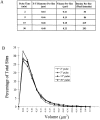Spatial and temporal dynamics of DNA replication sites in mammalian cells
- PMID: 9852140
- PMCID: PMC2132991
- DOI: 10.1083/jcb.143.6.1415
Spatial and temporal dynamics of DNA replication sites in mammalian cells
Abstract
Fluorescence microscopic analysis of newly replicated DNA has revealed discrete granular sites of replication (RS). The average size and number of replication sites from early to mid S-phase suggest that each RS contains numerous replicons clustered together. We are using fluorescence laser scanning confocal microscopy in conjunction with multidimensional image analysis to gain more precise information about RS and their spatial-temporal dynamics. Using a newly improved imaging segmentation program, we report an average of approximately 1,100 RS after a 5-min pulse labeling of 3T3 mouse fibroblast cells in early S-phase. Pulse-chase-pulse double labeling experiments reveal that RS take approximately 45 min to complete replication. Appropriate calculations suggest that each RS contains an average of 1 mbp of DNA or approximately 6 average-sized replicons. Double pulse-double chase experiments demonstrate that the DNA sequences replicated at individual RS are precisely maintained temporally and spatially as the cell progresses through the cell cycle and into subsequent generations. By labeling replicated DNA at the G1/S borders for two consecutive cell generations, we show that the DNA synthesized at early S-phase is replicated at the same time and sites in the next round of replication.
Figures








Similar articles
-
Electron microscopy of DNA replication in 3-D: evidence for similar-sized replication foci throughout S-phase.J Cell Biochem. 2005 Jan 1;94(1):126-38. doi: 10.1002/jcb.20300. J Cell Biochem. 2005. PMID: 15523671
-
Nuclear matrix support of DNA replication.J Cell Biochem. 2005 Dec 1;96(5):951-61. doi: 10.1002/jcb.20610. J Cell Biochem. 2005. PMID: 16167334 Review.
-
Visualising chromosomal replication sites and replicons in mammalian cells.Methods. 2012 Jun;57(2):140-8. doi: 10.1016/j.ymeth.2012.05.006. Epub 2012 Jun 6. Methods. 2012. PMID: 22683305
-
Early replication signals in nuclei of Chinese hamster ovary cells.Histochemistry. 1990;94(4):435-40. doi: 10.1007/BF00266452. Histochemistry. 1990. PMID: 2228739
-
DNA replication and nuclear architecture.J Cell Biochem. 2002;85(1):1-9. J Cell Biochem. 2002. PMID: 11891845 Review.
Cited by
-
Fiber-Like Organization as a Basic Principle for Euchromatin Higher-Order Structure.Front Cell Dev Biol. 2022 Jan 31;9:784440. doi: 10.3389/fcell.2021.784440. eCollection 2021. Front Cell Dev Biol. 2022. PMID: 35174159 Free PMC article.
-
Processive DNA synthesis is associated with localized decompaction of constitutive heterochromatin at the sites of DNA replication and repair.Nucleus. 2019 Dec;10(1):231-253. doi: 10.1080/19491034.2019.1688932. Nucleus. 2019. PMID: 31744372 Free PMC article.
-
The neoselectionist theory of genome evolution.Proc Natl Acad Sci U S A. 2007 May 15;104(20):8385-90. doi: 10.1073/pnas.0701652104. Epub 2007 May 9. Proc Natl Acad Sci U S A. 2007. PMID: 17494746 Free PMC article.
-
Functional architecture in the cell nucleus.Biochem J. 2001 Jun 1;356(Pt 2):297-310. doi: 10.1042/0264-6021:3560297. Biochem J. 2001. PMID: 11368755 Free PMC article. Review.
-
Human genome replication proceeds through four chromatin states.PLoS Comput Biol. 2013;9(10):e1003233. doi: 10.1371/journal.pcbi.1003233. Epub 2013 Oct 10. PLoS Comput Biol. 2013. PMID: 24130466 Free PMC article.
References
-
- Aten JA, Bakker PJM, Stap J, Boschman GA, Veenhof CHN. DNA double labeling with IdUrd and CldUrd for spatial and temporal analysis of cell proliferation and DNA replication. Histochem J. 1992;24:251–259. - PubMed
-
- Belmont AS, Braunfeld MB, Sedat JW, Agard DA. Large-scale chromatin structural domains within mitotic and interphase chromosomes in vivo and in vitro. Chromosoma. 1989;98:129–143. - PubMed
-
- Berezney, R. 1984. Organization and functions of the nuclear matrix. In chromosomal nonhistone proteins. L.S. Hnilica, editor. CRC Press Inc., Boca Raton, FL. 4:119–180.
-
- Berezney R. Visualizing DNA replication sites in the cell nucleus. Semin Cell Biol. 1991;2:103–115. - PubMed
-
- Berezney R, Buchholtz LA. Dynamic association of replicating DNA fragments with the nuclear matrix of regenerating liver. Exp Cell Res. 1981;132:1–13. - PubMed
Publication types
MeSH terms
Substances
Grants and funding
LinkOut - more resources
Full Text Sources
Other Literature Sources
Miscellaneous

